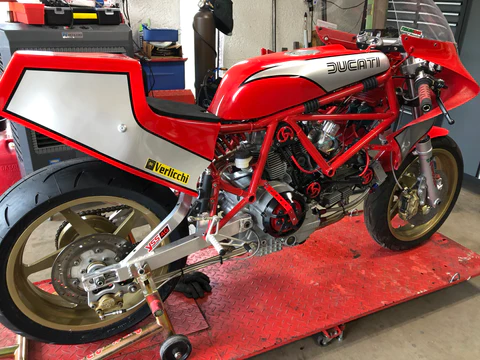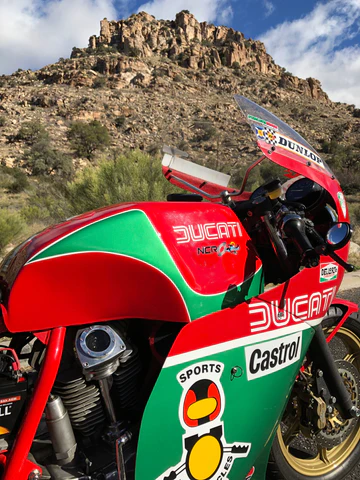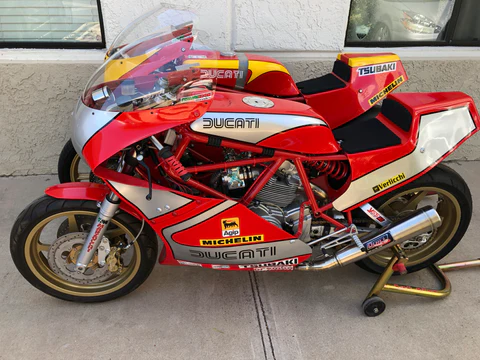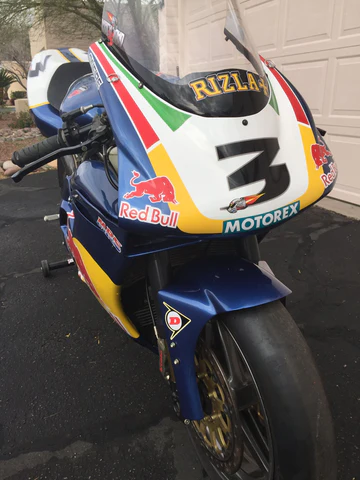Our TT 1000 Racer uses 36 mm SmartCarb Flat-Slides, Not Injection, Blog #1
Posted by Scot Wilson on Oct 11th 2019

The purpose of this series of Blog Posts is to discuss a new perspective as it relates to our preference for the use of our SmartCarb Flat-Slide carbs instead of fuel injection for many motorcycle applications. We have found that having the correct carbs can transform both modern and vintage Ducati 2 and 3 valve engine applications in a number of beneficial ways. To determine the correct size of carb to use on our TT 1000, we decided to match as closely as possible the 35 mm size of the inlets of our Ducati 1000 cc S2R engine that comes from the factory with fuel injection. We knew that we could use 36 mm SmartCarb Flat Slide carbs to maximize a direct and efficient flow of the fuel mixture just like fuel injection and to minimize the effect of any unwanted turbulence. We were proven correct when we took our TT 1000 to the dyno and our carbs never faltered.

Due to the technological advantages of our SmartCarbs, we knew that like fuel injection, that these flat-slide carbs were more than up to the task of delivering a constant, linear fuel mixture through the entire rev range of 9500 rpm for our Ducati 1000 DS Monster engine. Due to the "pressurized" float bowls of our 36 mm SmartCarbs, we get linear "injection" of the fuel mixture into our engines much like electronic fuel injection and without the need of an ECU! These 36 mm SmartCarbs were more than sufficient in fulfilling the fuel mixture requirements of this big 1000 cc engine. It has been determined through our analysis that larger carburetors are not necessary. Seen below is Corey Dyess, CEO of Technology Elevated working with us at Evan Steel Performance as we "dial-in" our 36 mm SmartCarb flat-slides.
Additionally, when I took my 1981 Ducati 900 ss MHR with SmartCarbs to the top of Mt Lemmon which is 10,000 ft, another benefit of our flat slide carbs was realized when there was no loss of power during the entire ride and no need to adjust the carbs as they automatically adjusted to changes in altitiude and any other atmospheric changes by design. However, Smart Carbs have also been put to the test at the Pikes Peak International Hill Climb which is a grueling road race that starts at 9300 feet in altitude and climbs up to 14,110 feet in less than 13 miles!! Two racing quads were outfitted with SmartCarbs and they achieved a 1st and 2nd Place Finishes!!

As mentioned in earlier blog posts, the technical benefits of the SmartCarbs are a 30% saving in fuel consumption, 6 to 14% improvement in HP, adaptability to altitude and other atmospheric changes, ease of adjustment and 80% less hydrocarbon emissions. Ease of adjustment and tuning remains one of the most significant benefits of using our SmartCarb flat-slide carbs. Once set there is no need for constant fiddling or adjusting of the settings. Also, there is no need for expensive ECU's to perform fuel management. We have found that for both modern and vintage Ducati twins, that our SmartCarbs are not just equal to, but superior to injection as a complete "value proposition". We are getting superior performance from these easy-to-tune carbs as well as better fuel economy.

The SmartCarbs have completely transformed the performance of my 1981 Ducati 900 ss MHR that I published on my 21 Sept 19 blog post. Yet, how can I contend that our SmartCarbs are a better solution for most applications than fuel injection? Our theory is that regardless of the method of delivering the fuel mixture, the bigger issue with burning hydrocarbon fuels in general and gasoline in particular, is that fuel is sticky. This means that the fuel molecules try to stick together due to the static created by free-roaming hydrocarbons found in ordinary fuels. Gasoline does not burn efficiently as its energy potential is "harnessed" inside of its liquid form. For this energy within the fuel to be fully released or to combust, it needs to be mixed with air, atomized, and vaporized. This transformational process results in the fuel changing from fine liquid particles to a gaseous state and carbs have this proactive advantage.

According to the engineers at Technology Elevated, SmartCarbs and carburetors, in general, have the ability to "proactively and more effectively assist the atomization process by emulsifying the fuel with air prior to entering the air stream flowing into the engine." This process often provides superior atomization and ultimately better vaporization of the fuel compared to fuel injection. In contrast, fuel injectors must inject fuel that is primarily in a liquid form directly into the engine and therefore, not as efficiently.

SmartCarbs from a technical perspective, initiate the emulsification and the atomization processes early due to the design on the carburetor itself and the technological advancements made by Technology Elevated specifically. As the air and fuel are pulled through the emulsion tube (above and below); the vaporization occurs in the remaining intake tract. This is just one example. However, as there are literally hundreds of carburetor designs, almost all of these designs will provide better emulsification and atomization results in comparison to fuel injection it has been shown.


Fuel injection, in contrast requires liquid fuel to be fed through high pressure lines purged of any air. Fuel Injection provides, therefore, no practical means of pre-aeration (emulsifying) of the liquid fuel before it enters the intake tract. The liquid fuel tries to atomize as it is being squirted out of the injector. Due to the inherent stickiness of the gasoline, it quickly begins to cast away from the air molecules being pumped through the intake tract it has just entered. "Fuel components, being heavier than air, tend to cast out and away from the swirling air mass that is trying to mix with it, as illustrated below." according to the Technology Elevated engineers.


The sole benefit of Electronic Fuel Injection is its ability to digitally control the amount of the fuel spray; not the quality of the fuel spray. The reverse can be said of most conventional carburetors. This begs the question: what if we can demonstrate that SmartCarb flat-slide carbs can provide the combined benefits of both carburation and fuel injection and more cost effectively? Fuel injection requires expensive electronic control devices and sensors that are typically twice or three times the cost of simple carburetion. Ducati Corse Superbikes did introduce "Shower-Injection" systems as a means to "dump" the necessary amount of fuel mixture for their high-reving 4 Valve (per cyclinder) Desmoquattro race engines as found on my Ducati 996 rs. I find fuel injection in this example to be more appropriate for these modern race engines that consume massive amounts of fuel and simultaneoiusly rev extremely high (over 10,000 rpm). However, in other applications, as more fuel is being "dumped" into the throttle bodies by fuel injection, the more the fuel has been shown to get wasted and not as efficiently utilized.

Current benefits of SmartCarb technology exist for a wide range of Ducati single and twin cylinder applications as a superior option to fuel injection that has been until recently a very prolific, yet now dated technology. The science and technology of the SmartCarb fuel system is leading the way to an entire new market of “Smart Carburation” systems. In future blogs, I will get into more detail that demonstrates our thesis as to how the current technology of our dynamic SmartCarb carburetors can provide superior performance over dated fuel injection technology for a wide range of Ducati motorcycle engines.

Through our sister company, BritIron Classics and our new affiliation with Molnar Manx after their acquisition of Two Wheel Classics-UK, we will be building some Norton racers and will be exploring what significant advantages can be gained through using SmartCarb flat slide carbs on British motorcycles. Stay tuned.
